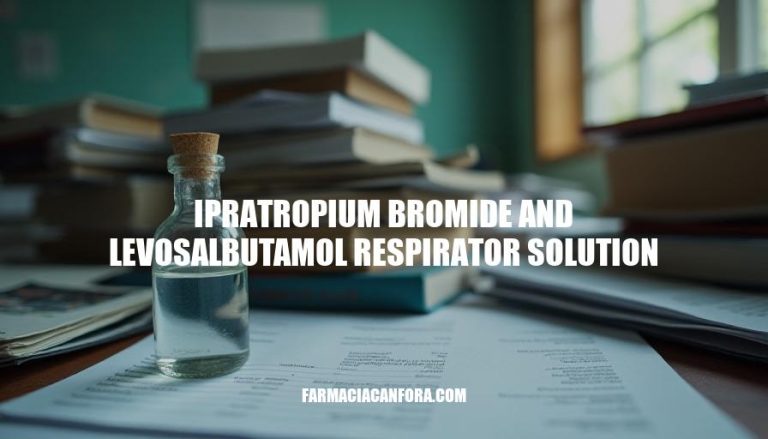Ipratropium bromide and levosalbutamol respiratory solution is a combination medication used to manage respiratory conditions like asthma and chronic obstructive pulmonary disease (COPD). Levosalbutamol, a bronchodilator, relaxes airway muscles to improve airflow, while ipratropium bromide, an anticholinergic, helps to open the airways by blocking certain neurotransmitters. This combination is significant for providing quick relief from symptoms such as wheezing, shortness of breath, and chest tightness.
Mechanism of Action
Here’s a concise explanation:
Ipratropium Bromide:
- Role: Anticholinergic
- Mechanism: Blocks the action of acetylcholine, a neurotransmitter that causes airway muscles to contract and narrow. By inhibiting acetylcholine, ipratropium helps relax and dilate the airways, improving airflow.
Levosalbutamol:
- Role: Bronchodilator
- Mechanism: Acts as a beta-2 adrenergic agonist. It relaxes the smooth muscles in the airways, leading to their dilation and improved airflow. This helps relieve symptoms like wheezing and shortness of breath.
Together, these medications work synergistically to enhance bronchodilation and improve breathing in conditions like asthma and COPD.
Clinical Applications
Ipratropium bromide and levosalbutamol respiratory solution is primarily used to treat asthma and chronic obstructive pulmonary disease (COPD).
Asthma
- Asthma: This solution helps manage asthma by relaxing the muscles around the airways, reducing bronchospasm, and improving airflow. Levosalbutamol acts as a bronchodilator, providing quick relief from symptoms like wheezing, shortness of breath, and chest tightness.
Chronic Obstructive Pulmonary Disease (COPD)
- COPD: For COPD, the combination of ipratropium bromide and levosalbutamol works to alleviate chronic symptoms such as persistent cough, wheezing, and difficulty breathing. Ipratropium bromide, an anticholinergic, helps to keep the airways open by blocking the action of acetylcholine, which can cause airway constriction.
This combination therapy is effective in providing both immediate relief and long-term control of symptoms in these respiratory conditions.
Dosage and Administration
Recommended Dosage and Methods of Administration
Ipratropium Bromide and Levosalbutamol Respirator Solution:
Important Notes
- Consistency: Use the medication exactly as prescribed by your healthcare provider.
- Safety: Do not exceed the recommended dosage or frequency.
- Monitoring: Regularly consult your doctor to monitor your condition and adjust the dosage if necessary.
Always follow your healthcare provider’s instructions to ensure safe and effective use of the medication.
Side Effects
Common Side Effects
- Dry mouth
- Throat irritation
- Headache
- Dizziness
- Cough
- Increased heart rate
Serious Side Effects
- Difficulty breathing
- Chest pain
- Allergic reactions (e.g., rash, itching, swelling)
- Palpitations
- Urinary retention
- Blurred vision
Guidance
- Common Side Effects: If you experience common side effects, monitor your symptoms. If they persist or worsen, contact your healthcare provider.
- Serious Side Effects: Seek immediate medical attention if you experience any serious side effects. Call emergency services or go to the nearest hospital.
Precautions and Interactions
Precautions:
- Allergic Reactions: Avoid if allergic to ipratropium, levosalbutamol, atropine, or their derivatives.
- Medical Conditions: Use with caution if you have narrow-angle glaucoma, prostatic hypertrophy, bladder neck obstruction, or urinary retention.
- Paradoxical Bronchospasm: Stop use and seek medical help if breathing or wheezing worsens.
- Dizziness/Blurred Vision: Be cautious when driving or operating machinery.
Drug Interactions:
- Cromolyn Inhalation Solution: Do not mix with ipratropium solution containing benzalkonium chloride.
- Other Medications: Consult your doctor before using other prescription or OTC medications, including herbal or vitamin supplements.
Contraindications:
- Hypersensitivity: Do not use if you have a history of hypersensitivity to the components.
- Heart Conditions: Avoid if you have certain heart conditions like tachyarrhythmias or hypertrophic obstructive cardiomyopathy.
Stay safe and always consult your healthcare provider for personalized advice!
Ipratropium Bromide and Levosalbutamol Respirator Solution
Ipratropium bromide and levosalbutamol respirator solution is a combination medication used to manage respiratory conditions like asthma and chronic obstructive pulmonary disease (COPD).
It works by relaxing airway muscles with levosalbutamol, a bronchodilator, and opening the airways with ipratropium bromide, an anticholinergic. This combination provides quick relief from symptoms such as wheezing, shortness of breath, and chest tightness.
Indications and Usage
The solution is primarily used to treat asthma and COPD, helping to manage symptoms like persistent cough, wheezing, and difficulty breathing. It is effective in providing both immediate relief and long-term control of symptoms.
Dosage
The recommended dosage for adults is 1 inhalation (20 mcg ipratropium bromide/50 mcg levosalbutamol) four times a day, while children over 12 years old should use 500 mcg of ipratropium bromide three or four times a day.
Side Effects
Common side effects include dry mouth, throat irritation, and headache, while serious side effects may require immediate medical attention.
Precautions
Precautions include:
- Avoiding the medication if allergic to its components;
- Using caution with narrow-angle glaucoma, prostatic hypertrophy, bladder neck obstruction, or urinary retention;
- Being cautious when driving or operating machinery due to dizziness or blurred vision.


